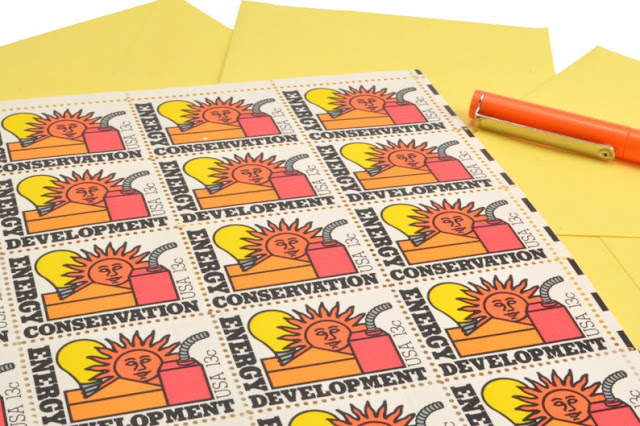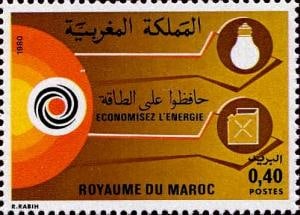"The world is on a highway to climate hell with our foot on the accelerator."
- Antonio Guterres, Secretary General, UN on 07 Nov 2022 at COP27 held at Sharm el Sheikh, Egypt.
According to BP Statistical Review of World Energy 2022, following are the release of carbon di oxide in the atmosphere from energy consumption by the top polluting countries of the world in 2021:
China = 10523.0 million tonnes
USA = 4701.1 million tonnes
India = 2552.8 million tonnes
The more we use fossil fuels like coal, petroleum oil and gas etc., to produce electricity or other forms of energy, the more we release of carbon di oxide in the atmosphere. Moreover, we shall have less fuel in the kitty for future. Energy conservation is the process of reduction of consumption of energy by various methods.
In order to highlight the need, and importance of energy conservation, and to create awareness on the subject, several countries have issued postage stamps on the topic.
Some of the simple ways for energy conservation are:
1. Switching off the light while leaving the room
 |
| LED & energy efficient devices: South Korea 01 Aug 2008 |
2. Replacing CFL bulbs with LED bulbs
 |
| De-plug & Earth Hour: Australia |
3. Unplugging the electrical devices when not in use
 |
| De-plugging: South Korea 01 Aug 2008 |
4. Setting of air-conditioner temperature at 26-28 degree Celsius in tropical countries
 |
| AC temperature monitoring: South Korea 01 Aug 2008 |
5. Walking down the nearby markets etc., rather than driving a car
6. Use of more public transport e.g. metro or tube railway etc.
 |
| Use public transport: South Korea 01 Aug 2008 |
Spain also issued a set of three stamps, one each highlighting public transport, room temperature and de-plugging of electrical devices.
 |
| Spain on Energy Conservation |
Symbolic bulbs were used in the stamps of China (15 July 1980), Greece (05 May 1980), and Japan (a set of two stamps on 01 Aug 1981).
 |
| China on Energy Conservation |
Energy efficient bulbs not only conserve energy but also saves money.
By energy conservation, we try to preserve the limited resources of energy. The approach helps in reducing the burning of fuels like coal, petroleum oil etc., and thereby saving the available resources, minimising waste, reducing cost and protecting environment. It is one of the solutions to mitigate the issues of pollution, release of Green House Gases (GHGs), global warming, etc. It also ensures a greener planet earth for the future generations.
Thus, it goes without saying that there is an urgent need to conserve energy by the global citizens.
 |
| US Post on Energy Conservation |
One 10 cent energy conservation stamp was issued by USA on the occasion of 50th anniversary of World Energy Conference held in Detroit, Michigan (23-27 Sept 1974). The stamp was designed by Robert W. Bode from Chappaqua, New York. Esther Porter was the modeler of the stamp and Howard F. Sharpless was the engraver. The stamps were printed by Offset and Giori.
Another related 13 cent stamp on ‘Energy and Development’ was released by US Post on 20 Oct 1977. Those stamps were printed by Bureau of Engraving and Printing.
 |
| Source: Internet |
France in 1978, drew attention towards economic parameters of energy conservation.
Spain issued a set of two stamps on ‘Save Energy’ on 24 Jan 1979.
A loud and clear message on ‘Save Fuel’ was conveyed through a pair of unique stamps by South Africa on 02 Apr 1979.
In 1979, Germany had issued a beautiful stamp on energy conservation.
In the following year, in 1980, Greece issued a pair of stamps on the theme.
 |
| Greece 1980 |
 |
| Greece 1980 |
Morocco issued stamp on the theme in 1980.
In the year 1981, Israel issued a stamp highlighting energy conservation. On the same theme, Algeria released commemorative postage stamp in 1990.
On 17 Aug 2005, Indonesia had released a stamp on similar theme.
 |
| Save Energy from Indonesia |
Let us have a look at the status of primary energy consumption of India.
(Figures in exajoules)
Sr. Fuels 2020 2021
1 Petroleum oil 9.08 9.14
2 Natural gas 2.18 2.24
3 Hydrocarbon subtotal 11.26 11.38
4 Coal 17.40 20.09
5 Nuclear 0.40 0.40
6 Hydroelectricity 1.55 1.51
7 Renewable energy 1.58 1.79
8 TOTAL 32.19 35.43
(Source: BP Statistical Review of World Energy 2022)
Energy hungry India observes ‘Energy Conservation Day’, every year on 14 December. The tradition began on 14 Dec 1991. The Bureau of Energy Efficiency (BEE), under the Ministry of Power, Government of India was tasked to create awareness among Indian citizen about the importance, various methods, associated benefits of reduction of energy consumption and its conservation practices. On 01 Oct 2001, BEE enacted Energy Conservation Act which became effective from 01 Mar 2002.
In the area of energy conservation, the government of India had started working long before. In 1977, it had established the Petroleum Conservation Research Association (PCRA) under Ministry of Petroleum and Natural Gas. In the year 1992, in order to give stress on the non-conventional sources of energy, the government of India established a separate exclusive ministry, called Ministry of New and Renewable Energy (MNRE).
 |
| Energy Conservation: India 14 Dec 2004 |
For a country like India, energy conservation is directly related to the savings of foreign exchange (used for import of petroleum and coal) and reduction of emission (target of net zero is 2070). India Post has issued commemorative stamps on energy conservation on 14 Dec 2004.
On 12 Dec 2022, Government of India approved Energy Conservation Bill (Amendment of Energy Conservation Act 2001), approved by Rajya Sabha, the Upper House on 12 Dec 2022 and Lok Sabha, the Lower House on 08 Aug 2022) paving the way for more fruitful results in this direction. It empowered federal government to specify a domestic carbon credit scheme. It also makes mandatory for the designated big power consumers to source a part of their energy needs from renewable resources. The Energy Conservation Code for buildings will also be applicable for office and residential buildings with a connected load of 100 kilowatt or above. Automobile manufacturers will have to gear up as the energy consumption standards may be specified for vehicles and ships.
Interestingly, the bill was brought by Ministry of Power and not by Ministry of Environment, Forest and Climate Change. Therefore, it will be the responsibility of BEE, as nodal agency, for implementation and monitoring.
Today, our earth disparately needs energy conservation measures for its future habitats and we all need to do our bits for a greener tomorrow.********
Disclaimer:
The noble objective of this blog, is to promote the hobby of philately through images of stamps, a few pictures and related narration. Some of the scans and pictures featured in this blogpost are mine while others (sourced from internet) are the properties of their respective owners. No intention to infringe any type of copyright.
The information provided in the article is for general informational purposes only. All information is provided in good faith. This is only for sharing of knowledge of philately with philatelist fraternity of the world. No commercial or political angle, whatsoever, is involved. Under no circumstances, I shall have any liability for reliance on any information provided in the story.










A very informative blog which tells us how the growth of energy needs and the rates of consumption are going to harm us in future and the minimal ways at an individual level which can help in minimizing this affect. Loved the way of writing and presenting.
ReplyDeleteThank you for reading and giving your valuable feedback. Regards.
DeleteFantastic Stamp collections. All the best Sir.
ReplyDeleteThanks a lot.
Delete